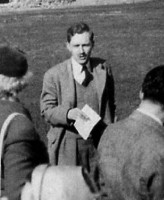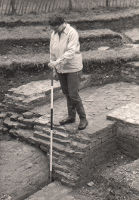About Us
History

The Enfield Archaeological Society was founded in 1955 by a small group of archaeology students, studying with the Workers' Educational Association under the British Museum's Dr John Kent. Under Dr Kent's mentorship, the EAS rapidly grew, organising coach trips, public meetings & exhibitions, and a varied and popular lecture programme that continues to this day.
The Society undertook its first excavation in 1956 on the site of the iron-age hill fort in Bush Hill, now recognised as one of the Borough's most important historical sites and a Scheduled Ancient Monument.

In the following years the EAS explored several sites in and around Enfield, and in 1963, under the direction of Ivy Drayton, the Society's work led to the rediscovery of Henry VIII's lost Tudor palace of Elsyng, within the modern-day grounds of Forty Hall.
Despite the site's scheduling, catastrophic damage was done in 1966/7 by the installation of a large gas main across the site, which would have gone unnoticed and unrecorded without emergency intervention by the EAS. Thanks to the Society, proctection of the site was subsequently greatly improved.
In 1971 the Society began a series of exploratory excavations in the south of the borough to investigate its Roman history, culminating in a series of important research and rescue digs in Bush Hill Park, uncovering a Roman roadside settlement; now one of our principal long term research projects, and the subject of our latest book: First Stop North of Londinium. We continue to monitor the area and periodically record archaeology revealed by ongoing housing development, often in cooperation with commercial units.
The EAS has been active in research and excavation in and around Enfield for many years and has produced a variety of published and unpublished material on subjects ranging from prehistory to the second world war.
In 2004 we began a long term project in cooperation with Historic England and Enfield Council, to conduct small scale annual research excavations on the site of Elsyng Palace, to better inform its interpretation and conservation. The digs take place in July as part of the nation-wide Festival of British Archaeology and are open to all our members, who range from enthusastic amateurs to seasoned professionals.












